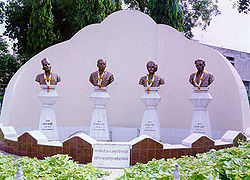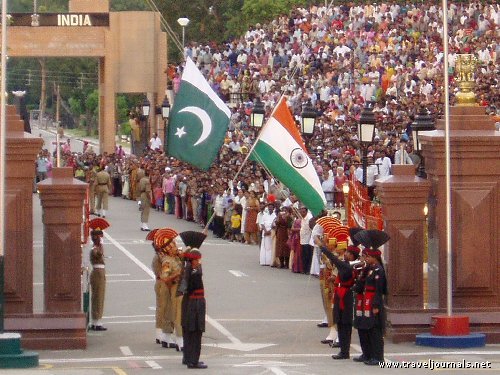
Page-1
|Page-2
|Page-3|Page-5|Page-6
|Page-7
|Page-8
|Page-9
| Page-10
| BaKhabar  Download pdf Download pdf
|
| Symbol
of National integration Abdul Rasul Qurban Hussein: The Martyr --- By Dr.
Shrikant Yelegaonkar, Solapur*
 The rising generation and the people in general are well-acquainted with the dedication of the four martyrs of Solapur who exhibited rare courage, valour, sacrifice and spontaneous patriotism and it’s a fact that if the people show optimum activism by realizing the history of the freedom struggle and self-governance, there will be a transformation of the self-governance into good-governance. Abdul Rasul Qurban Hussein was one of the four martyrs who sacrificed his life at the altar of India’s freedom struggle. Abdul Rasul Qurban Hussein, the martyr, was born to a frame-maker’s household in 1910. He was a talented mill worker. Lokmanya Tilak and Mahatma Gandhi had been his source of inspiration. He believed in the five-fold principles of Independence, preference to national goods, equality, socialism and Hindu-Muslim unity. He was known as a fire-brand Congress activist and a fine orator . He was known to have delivered inspiring speeches at the public meetings of the All India National Congress. He was a hard-core supporter of the Khaadi. As he had been participating in the public meetings, demonstrations and processions launched by Dr K.B.Antrolikar and his open subscription to the unity of Hindus and Muslims, he was liked by all. He set an example in patriotism and dedication. He was also secretary of the Youth League. He started a weekly entitled ‘Gazanfar’ in the year 1927; unfortunately it was terminated in 1930 in the wake of the Martial Law. He had been an active editor of Gazanfar, which means ‘lion’. The very title of the periodical indicates that Qurban Hussein was motivated by the ‘Daily Kesari’ run by Lokmanya Tilak. Although the language of Gazanfar was Urdu, it was printed in the Devnagari script. The emblem of the weekly was made up of two lions flanking the crescent and the sacred number 786. The editorials written by Qurban Hussein in ‘Gazanfar’ are worth reading, reflective, well-knit and motivating. He used his pen to preach people in the importance of freedom, preference to national goods, the Khaadi, Hindu-Muslim unity, welfare of the mill workers and socializing the functioning of the Solapur municipality. In one of the articles on the Islamic festival, viz. Ramazan, he urged the community to buy the clothes woven by the local weavers instead of purchasing the imported clothes, so that their weaver brothers and sisters would get morsels of food for survival and the customers in return would have blessings. His was a logical and practical-minded person. Thus, like Lokmanya, the maker of the ‘Gazanfar’ was totally aware of the fact that if Indians wanted to get rid of the British, they must get together keeping aside their religious differences. It is a fact that Hindu-Muslim integrity was his obsession. In an editorial devoted to the subject of the young generation and the divide, which is almost like an epic in ‘Integrity’, Hussein asserted that the young generation was the only ray of hope for India and he was optimistic that the youngsters would break the shackles and release India from the slavery. He continued by emphasizing that history would make the present youth a butt of ridicule, if, in spite of the illumination of ktnowledge, they remained stuck to the divide between Hinduism and Islam. He appealed to the young Indians that they should not pollute their hearts by the poison of religious narrow-mindedness. As he was an active and dutiful mill worker, he tried solving the problems of the workers in general with real urge and empathy, and at the same time he made his worker community aware of the significance of workers’ unions. He was one of the pioneers of the workers’ unions in Solapur. He would wield his pen to warn the workers who spent their hard-earned money on drinking liquor. He was entirely against the riot-mongers among the Hindu and Muslim religions. He would always say he would be the first to spill his blood for India’s freedom and national integrity. He was a personification of true patriotism. Hussein was implicated in a police burning case, due only to his unquenchable dedication towards India and his fire-brand philosophy. He was not deterred by the inhuman persecution and the fear of execution. When Poet Kunjvihari, one of his associates in the freedom fight, went to see Hussein in the prison, the latter consoled the poet by saying that he would render one of his famous poems while facing death by hanging. The theme of the poem was revival after death. On 12th January 1931 this luminous star went down the horizon, as he was hanged to death at the age of just 21. If today’s youth follow his example in genuine patriotism, they will certainly contribute to the process of strengthening national integrity. * Dr. Shrikant Yelegaonkar is an Associate Professor of Political Science, in S.S.A’s Arts & Commerce College, Solapur-413005. He can be contacted on Mob.09420357270 / 09923477386   |
India
and Pakistan: Lengthening Shadows of a Toxic Past –
Part5
… By Asma Anjum*
Sixty-four years after they
parted ways, their toxic past and violent split still continues to
haunt India and Pakistan and hundreds of millions of people on both
sides of the divide.
Note: Part-1 of this long essay appeared in the April issue of BaKhabar, Part-2 in May issue, Part-3 in June issue, and Part-4 in July issue. This is the final part of this series of historical-but-still-highly-relevant essay which would finally unfold in a book, insha-Allah, soon. ------------------------ In conclusion, it could be argued that the Hindu-Muslim split was a historical fact. What the Partition did was to bring it to the fore like never before. As Khilnani argues, “the pornography of borders, an imagery that at once excites, actually existing and aspiring nationalisms [separatisms] with the fantasy of fulfillment, and must always leave them with permanent disillusion, the melancholia of endless corridors of no man’s land. –The Idea of India [P..165] Remarkably, this disillusion, this melancholic concoction of hybrid emotions exists on both sides of the divide, even today. This catastrophe of Partition still has enough ammunition to perpetuate the historical enmity between the two nations. Bonded by their bitter past and present, they are locked in a perpetually antagonistic relationship.  Throwing the slur of Partition at an Indian Muslim and linking him to Pakistan in some way or the other is still the worst insult that can be heaped upon him. Sixty-four years after Independence, little has changed. I am reminded of Emperor Babur’s verse, the man who laid the foundation of the Mughal empire in Hindostan: Is there one cruel turn of Fortune’s wheel, unseen by me? Is there a pang, a grief my wounded heart has missed? --Like A King on Chessboard What hurts me the most is the fact that this tragedy and all the bloodshed and all the suffering that went with it could have been avoided, had there been a will, on the part of the leaders on both sides. When my friends from across the border express their huge admiration and awe for everything Indian and say they are dying to see the country, this sense of loss is accentuated. If only the Partition had been averted and had the ABC plan by the Cabinet Mission sent by British Prime Minister Clement Atlee been accepted, the subcontinent would have been a better place today. The Cabinet Mission proposed a loose federation of three provinces, each of which was given the option of opting out of the federation when they pleased. The Congress rejected it after first accepting it, which made the Muslim League to renounce constitutional methods and declare Direct Action Day, on August 6, 1946. This set in motion an unstoppable cycle of events leading to the split. The killings that began with the Hindu-Muslim riots in Calcutta continued for the next 13 months. Another mystery is Lord Mountbatten‘s declaring independence for India and Pakistan, an year or so before the scheduled time. The British under their Viceroy Lord Mountbatten perhaps were avenging the Muslims for their role in the first war of independence of 1857 that almost would have deracinated the British forever from East of Suez. They settled scores with the Muslims once and for all by cutting them to size and not just cutting their country into pieces, thus dealing a deadly blow to their economic, social, cultural and most importantly religious positions. The effect is felt even today, after a lot of proverbial water has gone under the bridge. Jinnah was offered a state with empty coffers and Gandhi‘s insistence to give Pakistan its dues, proved fatal for him. “Both India and Pakistan are my countries,” he is said to have insisted. “I am not going to take out a passport for going to Pakistan!” Those words sound so anachronistic, even absurd today. The toxic legacy of the past continues to bedevil the two countries. It continues to hold us, especially the Indian Muslims, to ransom. Our best bet is to go an extra mile to win our Hindu brethren’s hearts, making them realize that the well-being of the largest minority of our country is to the advantage of our nation. This should be a mutual effort which will help build a strong, prosperous and peaceful India, for us all--we the Indians. The wounds of the past can’t be allowed to fester forever. There must be an end to this madness, this lunacy of communalism. As for Pakistan, its creation might have been a tragedy for many in India and it may have its hands full of woes and warts of its own making but we cannot wish it away. A strong and stable Pakistan is in the interest of a strong and stable India and peace and stability in the subcontinent. Let us strive in our own small ways for this. Let peace prevail in our lands. Alternative to peaceful coexistence is mutual destruction. References: 1 . The Autobiography of an Unknown Indian, Nirad.C. Chadhury,Viking with JAICO Publishing House,1997 (first published:1951] 2. The Idea of India, Sunil Khilnani, 1998 [Penguin] 3. India After Gandhi, Ramchandra Guha, 2007, [Macmillan] 4. The Men I Met, M N Roy, 1968, [Janta Publications] 5. The End of India, Khushwant Singh, 2003, Penguin Books India.  * Asma Anjum (Khan), a social reformer, is exploring the partition of India with a view to understand the largest political divide of muslims in the 21st century. She can be contacted on asmaanjum.khan@gmail.com |
|
4
Home
| About
Us | Objective
| Scholarship
| Matrimonial
| Video
Library | Projects | Quran
Resources | Lend
a hand
|